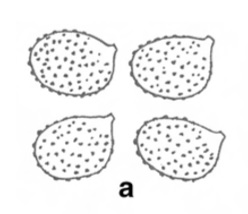Cortinarius alboamarescens Kytöv., Niskanen & Liimat
Index Fungorum number: IF551436 Facesoffungi number: FoF00996
Etymology: The name refers to the white colour of the basidiomata and the bitter taste.
Holotype: T. Niskanen 04-850, H6031311 (H). Pileus 10–30 mm, conical to hemispherical, then low conical to low convex, white to very pale ochraceous white, viscid to somewhat glutinous, with hygrophanous streaks. Lamellae almost crowded, adnexed, very pale brown. Stipe 35–60 mm long, 3–5 mm thick at apex, 4–7 mm at base, somewhat clavate, often slightly rooting at base, white, viscid. Universal veil viscid. Context very pale yellow, marbled hygrophanous. Odor of flesh sweetish. Taste bitter at least of the pileus surface. Basidia 4-spored. Basidiospores 5.2–6.3×4.1–5 μm (av. = 5.8×4.5 μm, 160 spores, 7 specimens), Q=1.17–1.40 (av. = 1.29), ovoidly subglobose, finely to fairly finely verrucose, somewhat dextrinoid. Lamellar trama hyphae smooth, sometimes finely granulose, pale yellowish to yellowish in Melzer’s reagent. Pileipellis hyphae in the surface layer narrow, 2–4 μm wide, hyaline, embedded in mucus. Hyphae under the surface layer 5–15 μm wide, pale yellow in Melzer’s reagent, not encrusted. ITS sequence (GenBank KR011136, holotype) distinct from the other known members of the section Vibratiles, and differs from them in the ITS region by more than 10 substitutions and indel positions.
Ecology and distribution: In coniferous forests, mostly in low-herb depressions of Picea forests, more seldom in pure Pinus heaths, one collection from Fagus forest, sometimes on calcareous ground. Often solitary or only a few basidiomata in each location. Producing basidiomata in late summer and autumn. Fairly rare to occasional, known from Northern and Central Europe.
Material examined: DENMARK, Nordjylland, Sindal, Tolne, small Fagussylvatica forest, 12 September 1998, leg. I. Kytövuori 98-1889 (H). GenBank ITS: KR011134. FINLAND, Varsinais-Suomi, Lohja, Esker of Lohja, outdoor recreation area by the road 36, dry pine (Pinus sylvestris) heath forest on sandy soil with lime dust effect, 19 September 2004, leg. I. Kytövuori & T. Niskanen 04-867, H6029887 (H). GenBank ITS: KR011137. Varsinais-Suomi, Vihti, Vihtijärvi, dryish pine forest with some Picea and Betula, 12 October 2003, leg. H. Tuovila 03-227 (H). Uusimaa, Helsinki, Herttoniemi, Kivinokka, mesic to grass-herb Picea forest, a shallow depression, 17 August 1994, leg. I. Kytövuori 94-061 (H); Malminkartano, 15 August 1979, J. Issakainen (H); Oulunkylän urheilupuisto, mesic to grass-herb Picea forest, 22 September 2000, leg. I. Kytövuori (H). Uusimaa, Inkoo, Kalasatama, mesic to grass-herb Picea forest, 3 September 2004, leg. I. Kytövuori (H). Uusimaa, Porvoo, W side of the lake Venjärvi, mesic to damp, mossy, grass-herb spruce forest (Picea abies) with some Populus tremula, Betula and Pinus sylvestris, 17 September 2004, leg. K. Liimatainen & T. Niskanen 04-850, H6031311 (holotype, H), (isotype, NY); Stensböle, Natura area, Picea abies dominated mesic grassherb forest with Betula, old wooded pasture land, 24 September 2012, leg. T. von Bonsdorff (H). Etelä-Savo, Leivonmäki, Selänpohja, Syysniemi, slightly paludified spruce forest with some hardwood trees and bushes, 22 August 1993, leg. I. Kytövuori 93-454 (H). Etelä-Häme, Lahti, Pesäkallio, spruce forest, 30 September 2002, leg. T. von Bonsdorff & I. Kytövuori (H). Etelä-Häme, Valkeakoski, Mälkiäinen, Kariniemi, on mossy ground in rich, mixed forest, 8 September 1990, K. Syrjänen (OULU). Etelä-Häme, Virrat, Pohjaslahti, Monoskylä, Hennilä, moist spruce forest, swampy depression, 19 October 1996, leg. I. Kytövuori 96- 1338 (H). Laatokan Karjala, Parikkala, Saari, congregation camp center at the lake, below the church, dry pine heath forest on fine sand, some Betula, 18 September 2009, leg. I. Kytövuori 09-1290 (H). Laatokan Karjala, Uukuniemi, Tarnala, mesic conifer forest, on the sawdust track, 11 September 2006, leg. I. Kytövuori 06-716 (H). Pohjois-Häme, Jyväskylä, Vesanka, Sivulanmäki NW, nature reserve, old Picea forest, 31 August 2014, leg. T. Jaakkonen (H). Pohjois-Häme, Konginkangas, Kivetty, mesic Picea forest, 9 September 2002, leg. H. Tuovila 02-026 (H). FRANCE, Haute-Savoie, pessière de Quintal, 24 October 1990, leg. P. Moënne-Loccoz 1761 (PC). SWEDEN, Medelpad, Ånge, Alby church yard, conifer dominated forest (Pinus, Picea) on calcareous soil, 28 August 2003, leg. I. Kytövuori, K. Liimatainen & T. Niskanen 03-823, H7018118 (H). GenBank ITS: KR011135. Medelpad, Liden, Sundsjöåsen Nature Reserve, mesic to grass-herb Picea forest, 13 September 2014, leg. I. Kytövuori (H). Härjedalen, Tännäs, Ramundberget, half-open pasture with thickets of Betula, Alnusincana and Populustremula, 18 August 2006, leg. M. Toivonen & I. Kytövuori 06-189 (H). Jämtland, Bräcke, Bodtjärnbäcken, spruce forest with some hardwood trees and bushes, 4 September 1997, I. Kytövuori 97-735 (H). Pite Lappmark, Arvidsjaur, Grundsel, dryish conifer forest with Picea, Pinus and some Betula, some moist depressions, 8 September 1997, leg. I. Kytövuori 97-970 (H).
Notes: Cortinarius alboamarescens is a small, white species with very small, almost subglobose spores. The viscid pileus and stipe, and the bitter taste place it in the /Vibratiles and the placement is confirmed in the phylogenetic analysis. Thus far, C. alboamarescens is the only known white species of the section that occurs in coniferous forests. Cortinarius leucophanes P. Karst. and C. lustratus Fr. Sensu Jeppesen et al. of the /Leucophanes are also white and occur in coniferous forests, but their basidiomata are somewhat larger, the taste is mild or farinaceous, and the spores are somewhat larger and ellipsoid.


